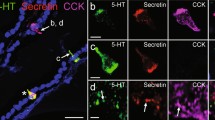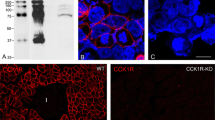Abstract.
ECL cells are numerous in the rat stomach. They produce and store histamine and chromogranin-A (CGA)-derived peptides such as pancreastatin and respond to gastrin with secretion of these products. Numerous electron-lucent vesicles of varying size and a few small, dense-cored granules are found in the cytoplasm. Using confocal and electron microscopy, we examined these organelles and their metamorphosis as they underwent intracellular transport from the Golgi area to the cell periphery. ECL-cell histamine was found to occur in both cytosol and secretory vesicles. Histidine decarboxylase, the histamine-forming enzyme, was in the cytosol, while pancreastatin (and possibly other peptide products) was confined to the dense cores of granules and secretory vesicles. Dense-cored granules and small, clear microvesicles were more numerous in the Golgi area than in the docking zone, i.e. close to the plasma membrane. Secretory vesicles were numerous in both Golgi area and docking zone, where they were sometimes seen to be attached to the plasma membrane. Upon acute gastrin stimulation, histamine was mobilized and the compartment size (volume density) of secretory vesicles in the docking zone was decreased, while the compartment size of microvesicles was increased. Based on these findings, we propose the following life cycle of secretory organelles in ECL cells: small, electron-lucent microvesicles (pro-granules) bud off the trans Golgi network, carrying proteins and secretory peptide precursors (such as CGA and an anticipated prohormone). They are transformed into dense-cored granules (approximate profile diameter 100 nm) while still in the trans Golgi area. Pro-granules and granules accumulate histamine, which leads to their metamorphosis into dense-cored secretory vesicles. In the Golgi area the secretory vesicles have an approximate profile diameter of 150 nm. By the time they reach their destination in the docking zone, their profile diameter is between 200 and 500 nm. Exocytosis is coupled with endocytosis (membrane retrieval), and microvesicles in the docking zone are likely to represent membrane retrieval vesicles (endocytotic vesicles).
Similar content being viewed by others
Author information
Authors and Affiliations
Additional information
Electronic Publication
Rights and permissions
About this article
Cite this article
Zhao, CM., Chen, D., Lintunen, M. et al. Secretory organelles in ECL cells of the rat stomach: an immunohistochemical and electron-microscopic study. Cell Tissue Res 298, 457–470 (1999). https://doi.org/10.1007/s004419900075
Received:
Accepted:
Issue Date:
DOI: https://doi.org/10.1007/s004419900075




